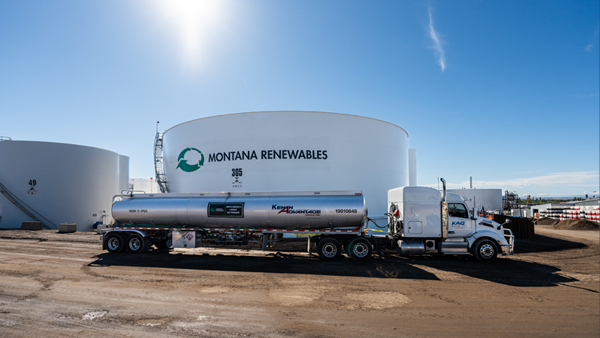
The United States has reached a pivotal moment in sustainable aviation fuel production, achieving approximately 30,000 barrels per day of production capacity in 2025. This milestone represents a dramatic transformation from just 2,000 barrels per day at the beginning of 2024, positioning America as a global leader in aviation decarbonization. The surge comes as new facilities in California, Texas, and Nevada come online, backed by federal incentives and state-level support programs.
Key SAF Production Facts
- Production capacity jumped from 2,000 to 30,000 barrels per day in just one year
- Phillips 66's Rodeo facility adds 10,000 BPD capacity in California
- Diamond Green Diesel contributes 15,000 BPD from Port Arthur, Texas
- New Rise Renewables brings 3,000 BPD online in Reno, Nevada
- Par Pacific planning additional 2,000 BPD capacity in Hawaii
Federal and State Incentives Drive Growth
The rapid expansion of SAF production stems from a combination of federal tax credits, the EPA's Renewable Fuel Standard, and aggressive state-level programs. These policy frameworks have created the economic foundation necessary for companies to invest billions in conversion projects and new facilities. International partnerships are also accelerating technology transfer and expanding global SAF supply chains.
The federal government's commitment extends beyond financial incentives to include research partnerships and regulatory frameworks that streamline SAF certification processes. State governments in California, Texas, and Nevada have implemented complementary programs that make domestic SAF production economically competitive with traditional jet fuel. These coordinated efforts have reduced investment risk and accelerated project timelines across the industry.

Regional Production Hubs Take Shape
Three key regions have emerged as SAF production powerhouses, each leveraging unique advantages and infrastructure. California leads with Phillips 66’s Rodeo facility, while Texas capitalizes on existing refinery infrastructure through Diamond Green Diesel’s Port Arthur expansion. Nevada’s New Rise Renewables facility demonstrates how smaller-scale operations can contribute meaningfully to national production capacity.
California's Strategic Position
California's SAF infrastructure benefits from the state's Low Carbon Fuel Standard and proximity to major airports. Phillips 66's Rodeo conversion represents the largest single SAF investment on the West Coast, processing renewable feedstocks into drop-in aviation fuel. The facility's strategic location serves both domestic and international routes from major California airports.
Texas Refinery Integration
Texas leverages existing petroleum infrastructure to accelerate SAF deployment. Diamond Green Diesel's Port Arthur facility demonstrates how traditional refineries can pivot toward renewable fuels production. The project's success has attracted additional investment throughout the Gulf Coast region, with several companies planning similar conversions.
Beyond Texas, regional projects in Quebec and other North American locations are expanding the continental SAF supply network. These cross-border initiatives strengthen energy security while building resilient supply chains for the aviation industry.

>> In Other News: Alaska Airlines, Cosmo Oil Marketing Sign SAF Sales Agreement For Hawaiian Airlines Osaka-Honolulu Flights
Industry Leadership and Technology Innovation
Calumet has emerged as North America's largest SAF producer, utilizing Topsoe's HydroFlex technology at its Montana facility. This partnership demonstrates how established energy companies are successfully transitioning to renewable fuel production through proven technology platforms.

"It's great to see the successful production of sustainable aviation fuel by Calumet. Actual production of SAF is crucial for decarbonizing aviation and demand for SAF will only grow the next many years."
Henrik Rasmussen, Managing Director, The Americas, Topsoe
The technology landscape includes multiple pathways for SAF production, from traditional HEFA processing to advanced conversion methods. Companies like LanzaJet are expanding market access through strategic partnerships, while Natural State Renewables is advancing forest biomass conversion technologies.
Major airlines are driving demand through direct investment and offtake agreements. Qantas committed AU$100 million to SAF development, while cargo carriers like FedEx are taking SAF deliveries at LAX and other major hubs. These corporate commitments provide the long-term contracts necessary for production facility financing.
Supply Chain Integration and Distribution
The SAF distribution network is expanding rapidly, with fuel suppliers like Neste extending supply to Ontario International Airport through partnerships with Amazon Air. This infrastructure development ensures SAF can reach airlines at competitive pricing while maintaining supply chain reliability.
| Production Facility | Location | Capacity (BPD) | Status |
|---|---|---|---|
| Phillips 66 | Rodeo, CA | 10,000 | Operational |
| Diamond Green Diesel | Port Arthur, TX | 15,000 | Operational |
| New Rise Renewables | Reno, NV | 3,000 | Operational |
| Par Pacific | Kapolei, HI | 2,000 | Planned 2025 |
Scaling Toward 2050 Decarbonization Goals
The International Air Transport Association estimates the aviation industry needs 120 billion gallons of SAF annually by 2050 to achieve net-zero emissions. Current US production represents a small fraction of this requirement, but the trajectory shows promising momentum. EIA forecasts suggest US biofuel production will more than double between 2024 and 2025, with SAF driving most of that growth.

"The production of renewable jet is another step toward our company's strategic goal to help decarbonize the airline industry. We are presently planning an expansion and a further increase to our SAF yield."
Bruce Fleming, CEO Montana Renewables and EVP Corporate Development
The next phase of SAF development will likely integrate hydrogen-derived fuels and advanced conversion technologies. Companies are investing in power-to-liquids facilities and synthetic fuel production, which could complement traditional biofuel pathways. These technologies offer the potential to scale SAF production beyond feedstock limitations while achieving even lower carbon intensities.
Regional cooperation across North America is strengthening the continental SAF supply base. Cross-border investments and technology sharing are creating integrated supply chains that serve both domestic and international aviation markets. This collaborative approach positions North America as a global leader in sustainable aviation fuel development.
Building the Foundation for Clean Aviation
The 30,000 barrels per day milestone marks more than just production capacity growth - it represents the successful transformation of policy frameworks, technology deployment, and industry collaboration. Regional hubs in California, Texas, and Nevada are demonstrating scalable approaches that other states can replicate, while international partnerships are strengthening global SAF supply chains.
As production continues scaling throughout 2025 and beyond, sustainable aviation fuel is positioned to become a cornerstone of North America's decarbonized transport future. The combination of proven technology, supportive policy frameworks, and strong industry commitment creates the foundation for continued expansion toward aviation's 2050 net-zero goals.
Subscribe to the newsletter
Daily decarbonization data and news delivered to your inbox
Follow the money flow of climate, technology, and energy investments to uncover new opportunities and jobs.
Latest issues
-
64 Carbon Projects Were Stuck. Texas Just Unlocked Them
Inside This Issue 🛢️ 64 Carbon Projects Were Stuck. Texas Just Unlocked Them ⚙️ In Ohio, Hydrogen Industry Presses on Despite Federal Uncertainty 🧲 Agami Zero Breaks Through With Magnetic Hydrogen...
-
This U.S. Plant Might Change Aviation Forever
In This Issue 🛫 A Georgia Plant Just Cracked Aviation's Fuel Puzzle 📉 CO2RE And ERM Release 2025 Update On Greenhouse Gas Removal Costs 🔗 Abatable Partners With BlueLayer To Streamline Corporate C...
-
Canada Just Made CCUS Way More Profitable
Inside This Issue 💼 Canada Unlocks EOR for Federal Tax Credits in Landmark Policy Shift 🚀 Carbontech Funding Opens as CDR Sector Pushes for Net-Zero Standard Revisions 💧 CHARBONE Confirms its Firs...
Company Announcements
-
Step strengthens Louisiana’s role in U.S. energy leadership and advances project finance process for biomass‑to‑fuel facility SACRAMENTO, Calif. & NEW ORLEANS -- DevvStream Corp. (Nasdaq: DEVS...
-
Climeworks Opens the World’s Largest Direct Air Capture Innovation Hub
Key takeaways: Climeworks launches the largest innovation center for Direct Air Capture, employing over 50 engineers in Zurich, Switzerland. The center is designed to reduce the cost and increase...
-
XCF Global Moves to Double SAF Production with New Rise Reno Expansion
Initial development completed at New Rise Reno 2, advancing XCF's second SAF production facility and positioning construction to begin in 2026. $300 million planned investment will double XCF'...
-
Carbon Capture Technology Relies on High-Performance CO2 Sensors
As the Global South's first Direct Air Capture (DAC) company, Octavia Carbon has commissioned the world's second DAC + geological storage plant. Harnessing Kenya's abundant renewable geothermal ene...